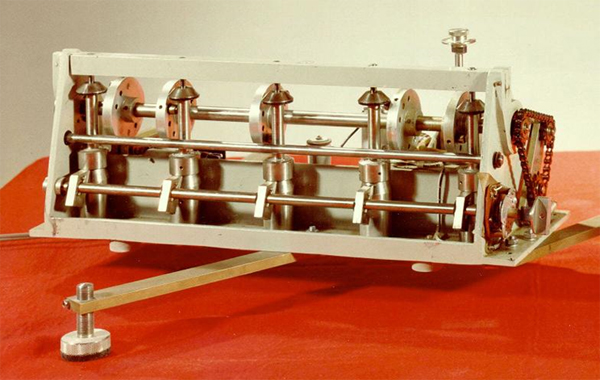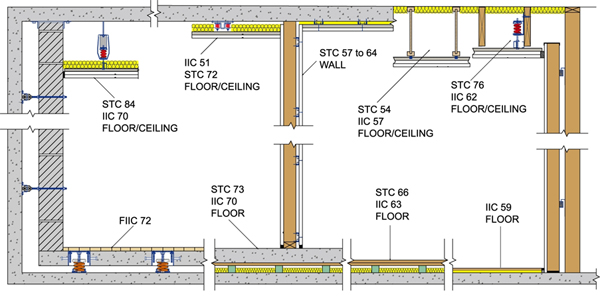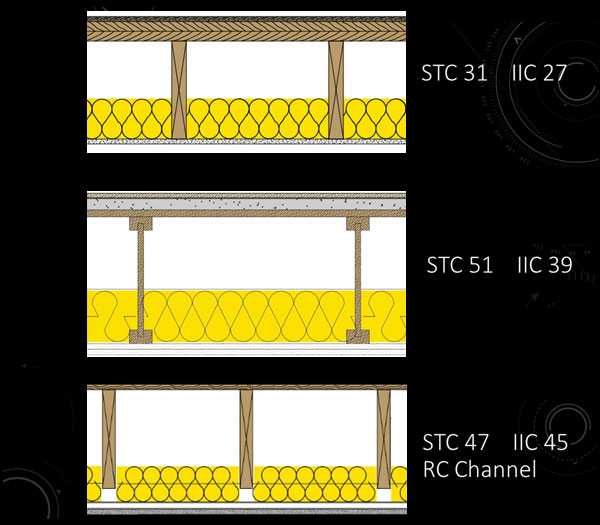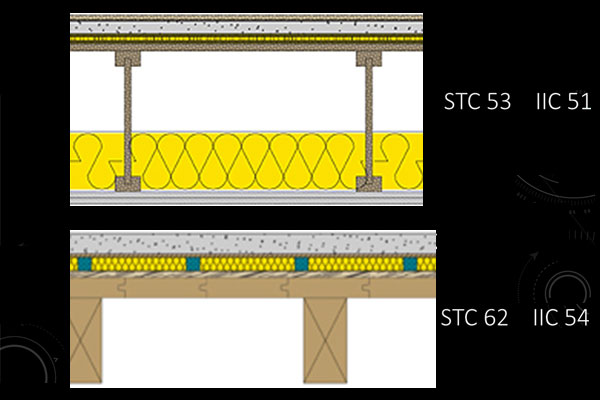Noise Control and Isolation for Multi-Family/Mixed Use Construction
Impact Insulation Class (IIC)
IIC is a single number rating that provides a means of comparing the acoustical performance of floor-ceiling assemblies, when excited by impact. Such structure-borne noises include footsteps, pans and toys dropping to the floor, chair movements, exercise equipment, trash chutes, exterior surface traffic. A larger number means more attenuation. IIC values are obtained through laboratory testing.
International Building Code allows for field-testing of STC and IIC, which are referred to as FSTC and FIIC, respectively. These sound tests utilize the same lab testing methods as IIC and STC in the lab, but are conducted in an actual building after the floor-ceiling installation is completed.
One criticism of both the STC and IIC standard is that many bothersome low frequency noises—such as heavy impacts and subwoofers—are not part of the test frequency range. The wavelengths associated with these frequencies are quite large and can be difficult to control. An acoustical consultant should be directed to analyze proposed construction should these noises be a concern.

Photo courtesy of Kinetics Noise Control
Example of a tapping machine used to measure impact sound transmission of floor-ceiling assemblies.
Codes versus practical design requirements
What the codes say:
*The Uniform Building Code (UBC) for multi-family construction requires a minimum of STC of 50 for walls between occupant units. It also requires a minimum IIC and STC of 50 for walls and floor-ceiling assemblies.
*The U.S. Department of Housing and Urban Development guidelines recommend a slightly higher STC and IIC in multi-family units that are considered “luxury” in terms of cost and design: minimum of 55 for STC and IIC.
*FSTC and FIIC ratings five points below corresponding STC and IIC lab test ratings are allowed by code.
*Some state and local code authorities are stricter in enforcing requirements for STC and IIC between units.
While the above STC and IIC minimum ratings are code compliant, they usually do not meet noise attenuation requirements for any multi-family subsidized or high-end project. Acoustical consultants will often recommend STC/IIC values in the 60-plus range, especially for luxury residences.
Understanding and Utilizing Acoustical Test Data
With the various types and combinations of building materials available to the industry, it is not surprising that the sound test results among different floor/ceiling assemblies may vary significantly, depending on the assembly design and materials used. Manufacturers offering STC/IIC/FSTC/FIIC values should be prepared to supply a complete copy of the appropriate test(s). Design professionals should be suspicious if a copy of a test with a complete description of the tested assembly is not or cannot be provided.
Field-testing. In order to make comparisons of different products/assemblies, identical assembly systems must have been tested. Design professionals are advised to construct wall/floor/ceiling mockups on site for FSTC/FIIC testing. FSTC/FIIC tests should be performed to the appropriate standards by an acoustical consultant. If the proposed systems are tested under identical conditions, head-to-head comparisons are possible. In addition, subjective testing through site visits to similarly constructed systems can be useful.
Sound Isolation Assemblies
Multi-family construction can take the form of stick built duplexes to concrete deck high-rise luxury towers. Mixed use projects may employ a concrete deck to separate the commercial from the residential levels and then use wood frame for subsequent floors. Floor/ceiling sound isolation assemblies can easily be divided between concrete construction and wood frame. Within these divisions, noise control products are typically broken out between ceiling side and floor side noise treatments (sometimes both sides are necessary). Lastly there are different levels of performance within the flooring products and ceiling products, each with its own requirements for proper installation (typically these include overall height and amount of material required for floor/ceiling assembly). The challenge for the designer is to select the assembly that provides the required level of noise control performance without breaching the design constraints (exposed deck ceilings, flooring transitions, ceiling height, etc.).
Airborne and structure-born sounds between rooms can be managed by specifying architectural sound isolation assemblies. According to one leading manufacturer, additional costs for adding acoustical products to typical concrete and wood frame construction are $0.75 to $1.75 per sq ft.
High performing sound isolation assemblies utilize three principles:
*Mass of construction materials such as concrete slabs or plywood subfloors.
*Airspace between construction components.
*Resilient isolation element used to integrate mass and airspace.
Leading manufacturers offer a wide range of resilient sound isolation products that can help deliver desired STC and IIC values.

Drawing provided by Kinetics Noise Control
Acoustical design using sound isolating products can achieve predictable STC and IIC values.
The scale on some of the images is exaggerated to better illustrate the acoustic design strategy.
Wood Frame Construction: Floors
Wood frame construction, by its nature can present noise control challenges. As mentioned earlier, mass is a necessary part of noise control. While gypsum concrete is often added to wood frame assemblies, one can expect an obvious drop-off in airborne noise control when compared with the mass of a six-inch concrete deck. The stiffness of a floor is an indicator of how well it will transmit low frequency “thuds”. More flexible assemblies such as wood frame and even lightweight steel decking and concrete do a poor job mitigating impact noise due to the higher deflection of these systems. The trend away from carpet towards hard floor surfaces such as hardwood flooring, ceramic tile, quarry tile, marble, wood parquet, and vinyl tile are all areas where impact noise is of concern.

Images courtesy of Kinetics Noise Control
Typical assemblies of wood frame construction that has no sound isolating products

Images courtesy of Kinetics Noise Control
Sound isolating assemblies for wood frame construction. Noise control is addressed from the floor side:
Top: continuous floor underlayment.
Bottom: noise control is provided by creating an air space while maintaining an exposed wood ceiling. This solution is often used for industrial/loft/condo reconstruction.
NB drawings are not at the same scale.









